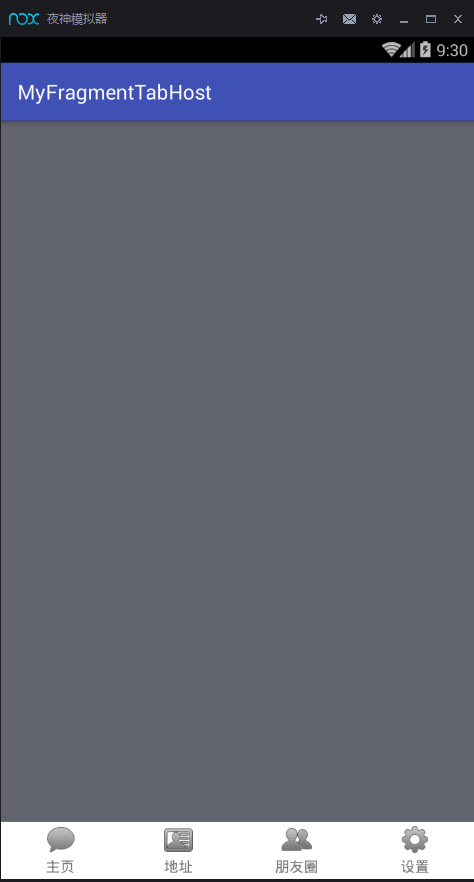Android -- FragmentTabHost实现微信底部切换
1,在商城类的项目中我们开始一个项目的时候经常出现这样的需求,如下图所示:

下面使用户可以切换的模块,上面是对应的模块的详细内容,实现这个效果有很多方式,可以使用radiobutton+fragment来实现,也可以用LinearLayout+fragment来实现,但是如何很快速的把我们的ui框架给搭建起来呢,今天就给大家介绍使用Fragment+FragmentTabHost来实现。
2,说一下FragmentTabHost实现的步骤吧:
①、Activity要继承FragmentActivity
②、调用FragmentTabHost的setup()方法
③、添加TabSpec
ok,那让我们一起来实现一下吧
首先,创建布局文件,可以看到,由于我们的fragment要放在FragmentTabHost的上面,所以创建了一个realtabcontent,但是官网给的给的FragmentTabHost的使用方法是必须在这个控件里面放一个fragment,那我们就来放一个假的fragment吧。布局代码如下:
<?xml version="1.0" encoding="utf-8"?>
<LinearLayout
xmlns:android="http://schemas.android.com/apk/res/android"
xmlns:tools="http://schemas.android.com/tools"
android:layout_width="match_parent"
android:layout_height="match_parent"
android:orientation="vertical"
tools:context="com.wangjitao.myfragmenttabhost.MainActivity"> <FrameLayout
android:id="@+id/realtabcontent"
android:layout_width="match_parent"
android:layout_height="0dp"
android:layout_weight="1"
android:background="@color/white"
/>
<android.support.v4.app.FragmentTabHost
android:layout_width="match_parent"
android:layout_height="wrap_content"
android:id="@+id/tabhost"
android:background="@color/white"
>
<FrameLayout
android:id="@android:id/tabhost"
android:layout_width="0dp"
android:layout_height="0dp"
android:layout_weight="0"
/>
</android.support.v4.app.FragmentTabHost> </LinearLayout>
然后我们要创建一个MainActivity,需要的是继承Fragment ,由于我们的AppCompatActivity是继承Fragment的(不知道的同学可以去看一下源码),所以我们直接去继承一下AppCompatActivity就行,这就实现了我们使用FragmentTabHost使用的第一个要求,然后找到我们的FragmentTabHost,调用其setup()方法
mTabHost.setup(this, getSupportFragmentManager(), R.id.realtabcontent);
可以看到,第一个参数是上下文环境,第二个参数是我们的FragmentManager,第三个参数是要与我们FragmentTabHost切换的同步的Fragment,ok这样我们的第二个要求就写完成了。然后是我们的四三个要求,添加TabSpec,代码如下:
mTabHost.addTab(mTabHost.newTabSpec(getString(mTabs.get(i).getTitle())).setIndicator(view),
mTabs.get(i).getFragment(), null);
首先我们要创建一个TabSpec,所以调用TabHost.newTabSpec(我们tab的title).setIndicator(对应的图标和文字的布局)
来看一下我们view的布局,很简单的,就是一个图标和一个textview
<?xml version="1.0" encoding="utf-8"?>
<LinearLayout xmlns:android="http://schemas.android.com/apk/res/android"
android:layout_width="match_parent"
android:layout_height="match_parent"
android:layout_gravity="center"
android:gravity="center"
android:orientation="vertical"
android:paddingBottom="3dp"
android:paddingTop="3dp"
> <ImageView
android:id="@+id/icon_tab"
android:layout_width="wrap_content"
android:layout_height="wrap_content"
/> <TextView
android:id="@+id/txt_indicator"
android:layout_width="wrap_content"
android:layout_height="wrap_content"
android:layout_marginTop="2dp"
android:textColor="@color/selector_tab_text"
/>
</LinearLayout>
ok,由于一个Tab对应的有一个title,一个icon,一个对应的fragment,所以我们可以把这个Tab抽出来,创建出来这个对象Tab.java
package com.wangjitao.myfragmenttabhost.bean; /**
* Created by jh on 2016/5/10.
*/
public class Tab {
private int title ;
private int icon ;
private Class fragment ; public Tab(int title, int icon, Class fragment) {
this.title = title;
this.icon = icon;
this.fragment = fragment;
} public int getTitle() {
return title;
} public void setTitle(int title) {
this.title = title;
} public int getIcon() {
return icon;
} public void setIcon(int icon) {
this.icon = icon;
} public Class getFragment() {
return fragment;
} public void setFragment(Class fragment) {
this.fragment = fragment;
}
}
ok,这样的话加上我们的选择器和对应的fragment,代码基本上就ok了
就简单的贴一个例子选择器和fragment代码就行了
TabHome.java
package com.wangjitao.myfragmenttabhost.fragment; import android.os.Bundle;
import android.support.annotation.Nullable;
import android.support.v4.app.Fragment;
import android.view.LayoutInflater;
import android.view.View;
import android.view.ViewGroup; import com.wangjitao.myfragmenttabhost.R; /**
* Created by jh on 2016/5/10.
*/
public class HomeFragment extends Fragment {
@Nullable
@Override
public View onCreateView(LayoutInflater inflater, ViewGroup container, Bundle savedInstanceState) {
View view = inflater.inflate(R.layout.tab_home, null);
return view;
}
}
对应的图片的selector
<?xml version="1.0" encoding="utf-8"?>
<selector xmlns:android="http://schemas.android.com/apk/res/android"> <item android:drawable="@drawable/weixin_pressed" android:state_selected="true"/>
<item android:drawable="@drawable/weixin_normal"/> </selector>
再加上对应的文字的selector
<?xml version="1.0" encoding="utf-8"?>
<selector xmlns:android="http://schemas.android.com/apk/res/android">
<item android:color="#0c760c" android:state_selected="true"/>
<item android:color="#0c760c" android:state_active="true"/>
<item android:color="#a9b7b7" android:state_selected="false"/>
<item android:color="#a9b7b7" android:state_active="false"/>
</selector>
MainActivity.java
package com.wangjitao.myfragmenttabhost; import android.content.Context;
import android.media.Image;
import android.support.v4.app.FragmentTabHost;
import android.support.v7.app.AppCompatActivity;
import android.os.Bundle;
import android.view.LayoutInflater;
import android.view.View;
import android.widget.ImageView;
import android.widget.LinearLayout;
import android.widget.TextView; import com.wangjitao.myfragmenttabhost.bean.Tab;
import com.wangjitao.myfragmenttabhost.fragment.AddressFragment;
import com.wangjitao.myfragmenttabhost.fragment.FindFriendFragment;
import com.wangjitao.myfragmenttabhost.fragment.HomeFragment;
import com.wangjitao.myfragmenttabhost.fragment.SettingsFragment; import java.util.ArrayList;
import java.util.List; public class MainActivity extends AppCompatActivity { private Context mContext = MainActivity.this ;
private FragmentTabHost mTabHost ;
private LayoutInflater mInflater ;
private List<Tab> mTabs = new ArrayList<>();
@Override
protected void onCreate(Bundle savedInstanceState) {
super.onCreate(savedInstanceState);
setContentView(R.layout.activity_main); //1,activity 继承FragmentActivity AppCompatActivity本身就是继承的FragmentActivity //2,调用FragmentTabHost的setup方法 // View view = mInflater.inflate(R.layout.tab_indicator,null) ;
// ImageView img = (ImageView) view.findViewById(R.id.icon_tab);
// TextView tex = (TextView) view.findViewById(R.id.txt_indicator);
//
//
// img.setImageResource(R.mipmap.tab_address_normal);
// tex.setText("主页");
//
// mTabHost.addTab(mTabHost.newTabSpec("home").setIndicator(view), HomeFragment.class, null); initTab();
} private void initTab() {
mInflater = LayoutInflater.from(this); mTabHost = (FragmentTabHost) findViewById(R.id.tabhost);
mTabHost.setup(this, getSupportFragmentManager(), R.id.realtabcontent); Tab tab_nome = new Tab(R.string.home,R.drawable.tab_weixin,HomeFragment.class) ;
Tab tab_address = new Tab(R.string.address,R.drawable.tab_profile,AddressFragment.class) ;
Tab tab_find_friend = new Tab(R.string.findfriend,R.drawable.tab_find,FindFriendFragment.class) ;
Tab tab_setting = new Tab(R.string.setting,R.drawable.tab_contact_list,SettingsFragment.class) ; mTabs.add(tab_nome);
mTabs.add(tab_address);
mTabs.add(tab_find_friend);
mTabs.add(tab_setting); for (int i = 0 ; i < mTabs.size() ;i++ ){
View view = mInflater.inflate(R.layout.tab_indicator,null) ;
ImageView img = (ImageView) view.findViewById(R.id.icon_tab);
TextView tex = (TextView) view.findViewById(R.id.txt_indicator); img.setImageResource(mTabs.get(i).getIcon());
tex.setText(mTabs.get(i).getTitle()); mTabHost.addTab(mTabHost.newTabSpec(getString(mTabs.get(i).getTitle())).setIndicator(view),
mTabs.get(i).getFragment(), null);
} mTabHost.getTabWidget().setShowDividers(LinearLayout.SHOW_DIVIDER_NONE);
mTabHost.setCurrentTab(0);
}
}
ok ,这样就完全实现了,看一下效果图(丑哭了,找不到好的UI图 \流泪):

Android -- FragmentTabHost实现微信底部切换的更多相关文章
- Android:仿微信开场切换界面
这实例很多人仿做,好实例还是不容错过!最重要是素材容易拿~ 效果: 默认3页面的切换,最后一个页面带按钮,点击进入另外一个页面 思路: 1.准备5个布局页面,1个为主函数布局页面,3个为切换的页面(其 ...
- Android Fragment实现微信底部导航
1.XML布局 (1)主界面 <?xml version="1.0" encoding="utf-8"?> <RelativeLayout x ...
- [Android] Android 使用 FragmentTabHost + Fragment 实现 微信 底部菜单
Android 使用 FragmentTabHost + Fragment 实现 微信 底部菜单 利用FragmentTabHost实现底部菜单,在该底部菜单中,包括了4个TabSpec,每个TabS ...
- Android典型界面设计——FragmentTabHost+Fragment实现底部tab切换
一.问题描述 在上次博文中,我们使用RadioGroup+ViewPage+Fragmen实现了顶部滑动导航(查看文章:http://www.cnblogs.com/jerehedu/p/460759 ...
- <Android 基础(三十三)> TabHost ~ 仿微信底部菜单
简介 Container for a tabbed window view. This object holds two children: a set of tab labels that the ...
- Android高仿qq及微信底部菜单的几种实现方式
最近项目没那么忙,想着开发app的话,有很多都是重复,既然是重复的,那就没有必要每次都去写,所以就想着写一个app通用的基本框架,这里说的框架不是什么MVC,MVP,MVVM这种,而是app开发的通用 ...
- Android之fragment点击切换和滑动切换结合
学了一小段时间的Android,主要接触的是UI设计,打交道最多莫过于fragment了吧.在Android3.0引入了fragment的概念后,几乎在所以的Android的应用中都可以看见其身影,已 ...
- FragmentTabHostBottomDemo【FragmentTabHost + Fragment实现底部选项卡】
版权声明:本文为HaiyuKing原创文章,转载请注明出处! 前言 使用FragmentTabHost实现底部选项卡效果. 备注:该Demo主要是演示FragmentTabHost的一些设置和部分功能 ...
- 用SQLite查看编辑android导出的微信聊天记录
上一篇我们已经能够完成文字版微信聊天记录导出android了,也即复制或剪切MicroMsg.db文件到电脑,以.db格式结尾的文件是数据库文件(database document),需要安装相关数据 ...
随机推荐
- MySQL-中文全文检索
一.概述 MySQL全文检索是利用查询关键字和查询列内容之间的相关度进行检索,可以利用全文索引来提高匹配的速度. 二.语法 1 2 MATCH (col1,col2,...) AGAINST (exp ...
- node.js学习路线图
http://www.admin10000.com/document/4624.html
- [LeetCode]题解(python):074-Search a 2D Matrix
题目来源 https://leetcode.com/problems/search-a-2d-matrix/ Write an efficient algorithm that searches fo ...
- CodeTimer
using System; using System.Collections.Generic; using System.Diagnostics; using System.Linq; using S ...
- ibatis传入数组或List
小结一下ibatis框架下,传入参数为数组类型或者是List类型的sql写法.标签里面都不需要表名 1.传入字符串数组,不需要标明parameterClasss,数组和List类型对象一样都可以用&l ...
- python join split
本文记录python,join和split函数的用法. 参考 http://blog.csdn.net/doiido/article/details/43538833 http://blog.csdn ...
- Java 日志管理最佳实践
转:http://blog.jobbole.com/51155/ 日志记录是应用程序运行中必不可少的一部分.具有良好格式和完备信息的日志记录可以在程序出现问题时帮助开发人员迅速地定位错误的根源.对于开 ...
- Apple Demo
https://developer.apple.com/library/ios/navigation/ http://developer.apple.com/library/ios/samplecod ...
- 当标签上写了runat="server" 后,<%%>就会无效
当标签上写了runat="server" 后,<%%>就会无效 //这是错误的写法 <input type="hidden" runat=&q ...
- IntelliJ IDEA 的 Java 热部署插件 JRebel 安装及使用
JRebel 介绍 JRebel for Intellij JRebel 在 Java Web 开发中, 一般更新了 Java 文件后要手动重启 Tomcat 服务器, 才能生效, 自从有了 JRe ...
